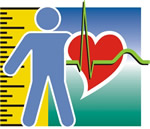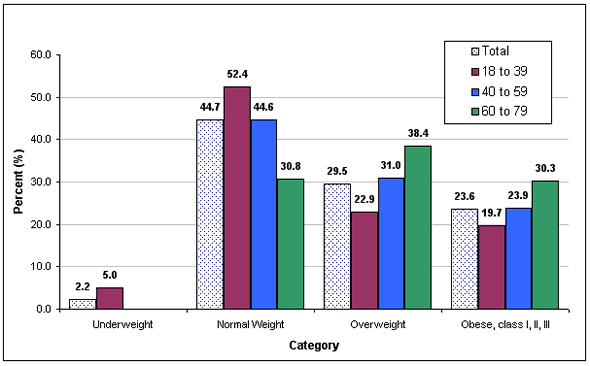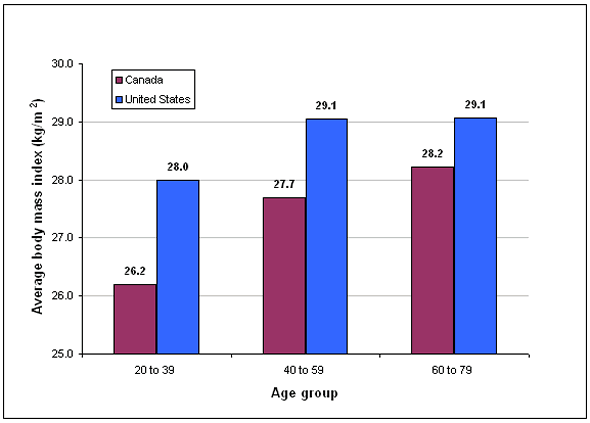Body composition of Canadian adults 2007 to 2009
Archived Content
Information identified as archived is provided for reference, research or recordkeeping purposes. It is not subject to the Government of Canada Web Standards and has not been altered or updated since it was archived. Please "contact us" to request a format other than those available.

Body mass index (BMI) increases with age for both men and women, more so for men than for women. Among men, BMI increases most markedly between those aged 18 to 39 and 40 to 59, while among women, BMI increases across all ages.
Chart 1
Distribution of men aged 18 to 79 among BMI categories

Note: Data for the underweight category is only published for the total population as the coefficient of variation was too high for smaller age groups.
Source: Canadian Health Measures Survey, 2007 to 2009
More than 4 out of 10 men have a BMI in the overweight range, while 3 out of 10 have normal weight.
Among women, the inverse is true: more than 4 out of 10 women have normal weight, while 3 out of 10 have a BMI in the overweight range.
Chart 2
Distribution of women aged 18 to 79 among BMI categories

Note: Data for the underweight category for two age groups were excluded because the coefficient of variation was too high.
Source: Canadian Health Measures Survey, 2007 to 2009
BMI of Canadians and Americans
Average BMI is slightly lower among Canadian adults than among Americans. Canadians aged 20 to 39 have a significantly lower average BMI at 26.2 kg/m2 than did Americans (28.0 kg/m2) in the same age group. Among people aged 40 to 59, Canadians have a significantly lower average BMI (27.7 kg/m2) than that of Americans (29.1 kg/m2). Among older adults, the difference in average Canadian and American BMI is not significant.
Chart 3
Comparison of average BMI among Canadian and American adults aged 20 to 79

Sources: Canadian Health Measures Survey, 2007 to 2009. National Health and Nutrition Examination Survey, 2007-2008.
Waist circumference
Average waist circumference increases with age among both women and men. However, female waist circumference is associated with higher health risks at a younger age than is the average waist circumference for males.
Health Canada's health risk classification suggests that for men a waist circumference ≥ 102 cm (40 in) and for women ≥ 88 cm (35 in) leads to an increased risk for developing health problems such as type 2 diabetes, coronary heart disease, and hypertension.
In Canada, the average waist circumference of men presents a low risk among those aged 20 to 39 (90.7 cm), a moderate risk among those aged 40 to 59 (98.7 cm) and a high risk among those aged 60 to 79 (102.5 cm). For women, the average waist circumference presents a moderate risk for those aged 20 to 39 (82.9 cm) and a high risk for those aged 40 to 59 (88.1 cm) and 60 to 79 (93.0 cm).
What is BMI?
Body mass index (BMI) is a ratio calculated using a person's weight in kilograms and height in metres squared (kg/m2) and is interpreted using a classification system developed by Health Canada in the following six categories:
| Less than 18.5 | Underweight |
| 18.5 to 24.9 | Normal weight |
| 25.0 to 29.9 | Overweight |
| 30.0 to 32.4 | Obese, Class I |
| 32.5 to 34.9 | Obese, Class II |
| 35.0 and over | Obese, Class III |
Body composition
Several anthropometric measurements were taken as part of the Canadian Health Measures Survey—height and weight, waist circumference, hip circumference and five skinfolds—on a sample of 3,700 adults aged 18 to 79 to obtain an overall picture of body composition, which can be linked to health benefits.
- Date modified:
